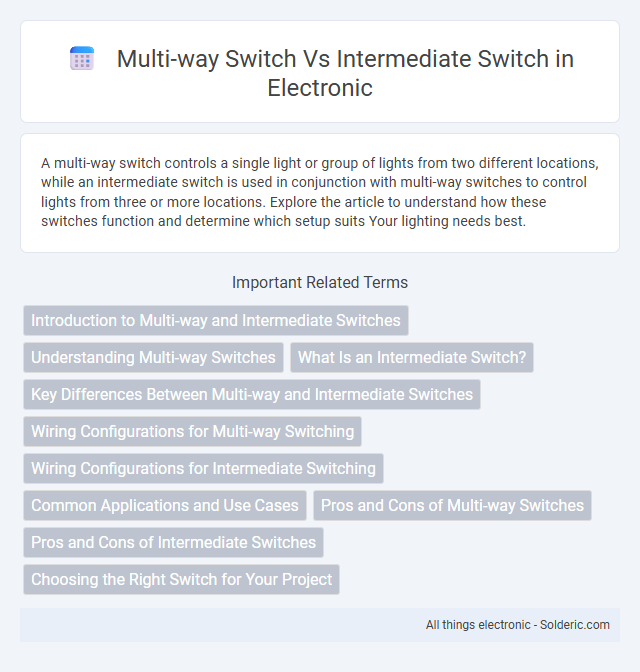A multi-way switch controls a single light or group of lights from two different locations, while an intermediate switch is used in conjunction with multi-way switches to control lights from three or more locations. Explore the article to understand how these switches function and determine which setup suits Your lighting needs best.
Comparison Table
| Feature | Multi-way Switch | Intermediate Switch |
|---|---|---|
| Usage | Controls a light from two locations | Controls a light from three or more locations |
| Installation | Requires two switches | Requires one or more intermediate switches between two multi-way switches |
| Wiring | Uses two travelers and one common wire | Uses four traveler wires to connect between multi-way switches |
| Switch Type | Single pole, double throw (SPDT) | Double pole, double throw (DPDT) |
| Function | Toggle light ON/OFF from two points | Toggle light ON/OFF from multiple points beyond two |
| Application | Staircases, hallways with two access points | Large hallways, long corridors with multiple control points |
Introduction to Multi-way and Intermediate Switches
Multi-way switches are designed to control a single light or group of lights from two or more locations, commonly used in staircases or long hallways. Intermediate switches serve as additional control points within a multi-way switching system, enabling light operation from three or more locations by working between two standard multi-way switches. The integration of multi-way and intermediate switches ensures flexible and convenient lighting control in complex electrical wiring setups.
Understanding Multi-way Switches
Multi-way switches enable control of a single light or group of lights from multiple locations, commonly used in hallways or staircases with two or three switches. Intermediate switches are used between two multi-way switches to extend the control to more than two locations, allowing complex switching configurations in larger spaces. Understanding the wiring and functionality of multi-way switches is essential for efficient electrical design and installation in residential and commercial buildings.
What Is an Intermediate Switch?
An intermediate switch is a specialized electrical switch used in multi-way lighting circuits to control a single light fixture from three or more locations. Unlike a standard multi-way switch, which only allows control from two points, intermediate switches are installed between two three-way switches to expand the number of control points. They feature four terminals that enable the switching paths to alternate, providing versatile and efficient lighting control in complex wiring setups.
Key Differences Between Multi-way and Intermediate Switches
Multi-way switches control a single light or group of lights from two different locations, commonly used in staircases or hallways, while intermediate switches provide control from three or more locations by being installed between two multi-way switches. Multi-way switches consist of two-position toggles or rockers, whereas intermediate switches have four terminals and allow circuit toggling between multiple paths. The key difference lies in their wiring complexity and application scope: multi-way switches enable two-way switching, and intermediate switches extend this capability for multi-way switching systems with three or more control points.
Wiring Configurations for Multi-way Switching
Multi-way switch wiring configurations involve connecting two or more switches to control a single light or set of lights from multiple locations. Typical setups include three-way switches with two switches and four-way switches that add intermediate switches between them to extend control points. Your choice between multi-way and intermediate switches depends on the number of control locations needed and the complexity of the wiring layout.
Wiring Configurations for Intermediate Switching
Intermediate switches are integral in wiring configurations where three or more switches control a single lighting circuit, typically installed between two standard three-way switches. The wiring for intermediate switching involves two traveler wires connecting the intermediate switch to the adjacent three-way switches, allowing for the interruption or redirection of current flow to control the load from multiple locations. This setup enhances flexibility in complex lighting schemes, ensuring seamless operation across various switch points by utilizing a four-wire traveler system between switches.
Common Applications and Use Cases
Multi-way switches are commonly used in residential and commercial lighting systems to control a single light fixture from two or more locations, such as hallways, staircases, and large rooms. Intermediate switches are specifically designed for systems requiring three or more switch locations, acting as a middle switch in a multi-way circuit to allow seamless on/off control from multiple points. These switches are essential in complex lighting setups, enhancing convenience and energy efficiency in buildings with extensive lighting networks.
Pros and Cons of Multi-way Switches
Multi-way switches offer the convenience of controlling a single light fixture from two different locations, making them ideal for staircases or large rooms. Their simple installation and reliable functionality are major advantages, but they can be less flexible compared to intermediate switches when more than two control points are needed. Your choice depends on the complexity of your lighting setup and the number of control locations required.
Pros and Cons of Intermediate Switches
Intermediate switches allow control of a single light from three or more locations, offering enhanced convenience in large rooms or long hallways. They can be more complex to install compared to standard multi-way switches, increasing wiring requirements and potential troubleshooting time. Your choice should balance the need for multiple control points against installation complexity and cost.
Choosing the Right Switch for Your Project
Selecting the right switch depends on the wiring configuration and the number of control points needed. Multi-way switches are ideal for controlling a single light or group of lights from two different locations, commonly used in staircases or hallways. Intermediate switches enable control from three or more locations, perfect for long corridors or large rooms requiring multiple access points.
Multi-way switch vs Intermediate switch Infographic

 solderic.com
solderic.com